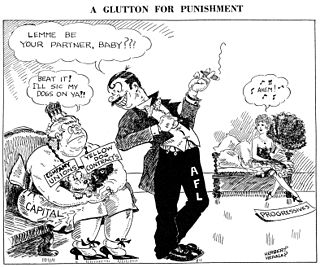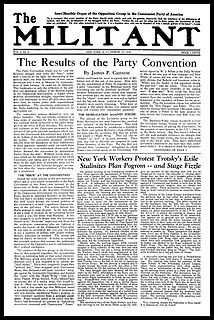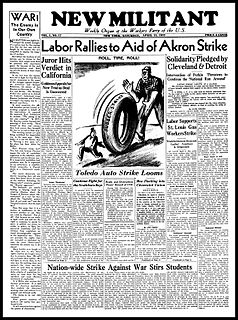Actions
The AWP sought to find what it called "an American approach" for Marxism at the depth of the Great Depression. The group published a popularly-written newspaper, Labor Action, and created Unemployed Leagues, which attracted tens of thousands of members and should not be confused with the Communist Party USA's Unemployed Councils.
The AWP is best known in labor history for its leadership of the successful 1934 Toledo Auto-Lite Strike, which foreshadowed the creation of the United Auto Workers union. Exerting influence through its Unemployed League chapter, the AWP in Toledo kept the Auto-Lite strike from being broken by the desperate unemployed. Instead, the AWP brought the mass of unemployed to bear as a powerful vehicle for solidarity with the auto parts factory workers on the picket lines. The Auto-Lite strike, along with the Minneapolis Teamsters Strike of 1934 (led by the Trotskyist Communist League of America) and the 1934 West Coast Longshore Strike (led by the Communist Party USA), was an important catalyst for the rise of industrial unionism in the 1930s, much of which was organized through the Congress of Industrial Organizations.
While it never actually attracted any workers, numbering no more than a few hundred members, the AWP attracted a number of prominent labor activists, such as J. B. S. Hardman of the needle trades. It also attracted a number of intellectuals, many of them former members of the Communist Party who rebelled against its strictures but remained radical. The latter included James Burnham, Sidney Hook, James Rorty, and V. F. Calverton.
Termination
In December 1934, the AWP merged with the Trotskyist Communist League of America, to form the Workers Party of the United States. That was the fusion of two revolutionary socialist organizations, which had both successfully led two militant strikes to victory. Most AWP members were absorbed into the mainstream Trotskyist movement, and some, like Burnham, became major figures in later 1930s.
A few others, such as Louis Budenz and Arnold Johnson, did not accept the rapprochement with Trotskyism and instead joined the Communist Party, considering its adoption of the Popular Front to be analogous to what the AWP had tried to accomplish with its "American approach."
Others, such as Hook and Rorty, became political independents but remained, for a time, largely sympathetic to the Workers Party of the United States.

Abraham Johannes Muste was a Dutch-born American clergyman and political activist. He is best remembered for his work in the labor movement, pacifist movement, antiwar movement, and civil rights movement.
Max Shachtman was an American Marxist theorist. He went from being an associate of Leon Trotsky to a social democrat and mentor of senior assistants to AFL-CIO President George Meany.

Martin "Marty" Abern (1898–1949) was a Marxist politician who was an important leader of the Communist youth movement of the 1920s as well as a founder of the American Trotskyist movement.
Farrell Dobbs was an American Trotskyist, trade unionist, politician, and historian.

The Minneapolis general strike of 1934 grew out of a strike by Teamsters against most of the trucking companies operating in Minneapolis, the major distribution center for the Upper Midwest. The strike began on May 16, 1934 in the Market District. The worst single day was Friday, July 20, called "Bloody Friday", when police shot at strikers in a downtown truck battle, killing two and injuring 67. Ensuing violence lasted periodically throughout the summer. The strike was formally ended on August 22.

Louis Francis Budenz was an American activist and writer, as well as a Soviet espionage agent and head of the Buben group of spies. He began as a labor activist and became a member of the Communist Party USA. In 1945 Budenz renounced Communism and became a vocal anti-Communist, appearing as an expert witness at various governmental hearings and authoring a series of books on his experiences.
Jake Cooper (1916–1990) was an American Socialist. He was active in the Minneapolis Teamsters Strike of 1934 led by the Communist League of America and later became a member of the Socialist Workers Party. As a leading member of the SWP, he was imprisoned under the Smith Act, together with many other SWP leaders, for opposing US involvement in the Second World War. Cooper was also a founding member of the Fourth International.

Albert Weisbord (1900–1977) was an American political activist and union organizer. He is best remembered, along his wife Vera Buch, as one of the primary union organizers of the seminal 1926 Passaic Textile Strike and as the founder of a small Trotskyist political organization of the 1930s called the Communist League of Struggle.

The Conference for Progressive Labor Action (CPLA) was a left-wing American political organization established in May 1929 by A. J. Muste, the director of Brookwood Labor College. The organization was established to promote industrial unionism and to work for reform of the American Federation of Labor. It dissolved itself in December 1933 to form the American Workers Party.

Albert Goldman (1897–1960) was a Belorussian-born American political and civil rights lawyer, closely associated with the American communist movement. Goldman broke with the mainline Communist Party, USA in 1933, joining the Trotskyist opposition, in which he would be a leading participant for the better part of the next two decades. Goldman is best remembered as a defendant and lead defense attorney in the 1941 Smith Act prosecution of the leadership of the Socialist Workers Party.

The Communist League of Struggle (CLS) was a small communist organization active in the United States during the 1930s. Founded by Albert Weisbord and his wife, Vera Buch, who were veterans of the Left Socialist movement and the Communist Party USA, the CLS briefly affiliated with Leon Trotsky independently of the Communist League of America. It was affiliated to the International Bureau of Revolutionary Youth Organizations until 1935. The small group dwindled and quietly was terminated in the spring of 1937.
Edward Hugo Oehler (1903–1983) was an American communist.
The Toledo Auto-Lite strike was a strike by a federal labor union of the American Federation of Labor (AFL) against the Electric Auto-Lite company of Toledo, Ohio, from April 12 to June 3, 1934.
Samuel "Sam" Pollock was an American labor union activist and leader. He helped lead two important strikes in 1934, the Auto-Lite Strike and the Hardin County onion pickers strike, before becoming district president of the Amalgamated Meat Cutters and Butcher Workmen of North America.

The Communist League of America (Opposition) was founded by James P. Cannon, Max Shachtman and Martin Abern late in 1928 after their expulsion from the Communist Party USA for Trotskyism. The CLA(O) was the United States section of Leon Trotsky's International Left Opposition and initially positioned itself as not a rival party to the CPUSA but as a faction of it and the Comintern. The group was terminated in 1934 when it merged with the American Workers Party headed by A. J. Muste to establish the Workers Party of the United States.

The Workers Party of the United States (WPUS) was established in December 1934 by a merger of the American Workers Party (AWP) led by A.J. Muste and the Trotskyist Communist League of America (CLA) led by James P. Cannon. The party was dissolved in 1936 when its members entered the Socialist Party of America en masse.

The Revolutionary Workers League (RWL) was a radical left group in the United States, lasting from 1935 through 1946. It was led by Hugo Oehler and published The Fighting Worker newspaper.

James Patrick Cannon was an American Trotskyist and a leader of the Socialist Workers Party.
The Socialist Workers Party (SWP) is a communist party in the United States. Originally a group in the Communist Party USA that supported Leon Trotsky against Soviet leader Joseph Stalin, it places a priority on "solidarity work" to aid strikes and is strongly supportive of Cuba. The SWP publishes The Militant, a weekly newspaper that dates back to 1928. It also maintains Pathfinder Press.
Vincent Raymond Dunne, also known as Vincent R. Dunne or Ray Dunne, was an American Trotskyist, teamster, lumberjack, and union organizer with the Industrial Workers of the World and the International Brotherhood of Teamsters. He is notable for his leading role in the 1934 Minneapolis general strike, his conviction and imprisonment under the anti-communist Smith Act, and his membership in the Socialist Workers Party and opposition to Stalinism.










